

For Education. Advent of Google means we must rethink our approach to education. Would a person with good handwriting, spelling and grammar and instant recall of multiplication tables be considered a better candidate for a job than, say, one who knows how to configure a peer-to-peer network of devices, set up an organisation-wide Google calendar and find out where the most reliable sources of venture capital are, I wonder?
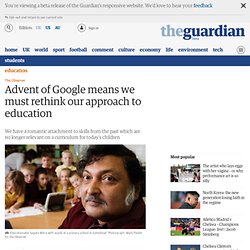
The former set of skills are taught in schools, the latter are not. We have a romantic attachment to skills from the past. Longhand multiplication of numbers using paper and pencil is considered a worthy intellectual achievement. Using a mobile phone to multiply is not. But to the people who invented it, longhand multiplication was just a convenient technology. In school examinations, learners must reproduce facts from memory, solve problems using their minds and paper alone. The curriculum lists things that children must learn. What’s the Big Deal about Blogs? You’re curious about blogging?
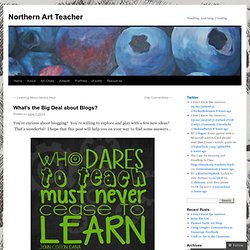
You’re willing to explore and play with a few new ideas? That’s wonderful! I hope that this post will help you on your way to find some answers… First, let’s start at the beginning: What is a Blog? I really appreciate reading blogs from other educators, and I learn a lot about student blogs because other teachers are willing to share the work from their classrooms. Building the Culture of an Empowered Mindset Towards Technology Innovation.
I have been having an incredible year of learning in my half-time role with Parkland School Division, along with speaking and consulting for other schools/districts.

I have learned a lot from both positions and I feel that it is very valuable to be able to look at school cultures within your organization, while also looking at what other schools do from an outsider’s perspective. In this work, I have realized how truly important the role of principal is in building, not only in creating a positive culture, but an innovative one. These schools continuously strive to understand the changes happening in our world to not only catch up, but to lead the way in providing amazing learning opportunities for our students. Often times, as the principal goes, so does the culture of the school. Stratosphere learning in a connected world. The state of the web - Spring 2012. The State of the Web - Summer 2011. The State of the Web - Winter 2010. 22 Useful Google Forms for Teachers and Principals. The 4 Stages of Technology Integration in Education. Back again to the topic of technology integration Vs using technology in education.
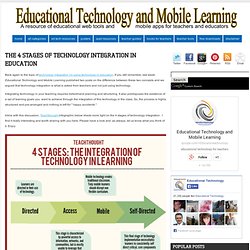
If you still remember, last week Educational Technology and Mobile Learning published two posts on the difference between these two concepts and we argued that technology integration is what is asked from teachers and not just using technology . Integrating technology in your teaching requires beforehand planning and structuring. 10 Ways To Promote Your School. Image Credit: blog.socialmaximizer.com There are so many neat ways to promote your school and/or district in this day in age.
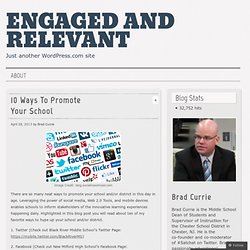
Leveraging the power of social media, Web 2.0 Tools, and mobile devices enables schools to inform stakeholders of the innovative learning experiences happening daily. Highlighted in this blog post you will read about ten of my favorite ways to hype up your school and/or district. 1. Twitter (Check out Black River Middle School’s Twitter Page: 13 Million Facebook Users Haven't Touched Their Privacy Settings. As Facebook prepares Graph Search for wide release, some have concerns about the privacy issues the new feature raises.
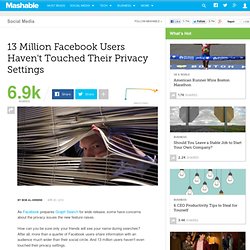
How can you be sure only your friends will see your name during searches? After all, more than a quarter of Facebook users share information with an audience much wider than their social circle. And 13 million users haven't even touched their privacy settings. To see how Graph Search will affect you, as well as a few helpful tips for customizing your privacy settings, check out this infographic, courtesy of Marketo. Are you worried about Graph Search invading your privacy?
Homepage image courtesy of Flickr, D. Web 2.0 Tools For The Classroom. A Printable Guide to Social Media [#Infographic] Cram a dozen educators into a conference room and ask them to name the most popular social media tools used by students, and it’s a safe bet everybody at the table could rattle off the top two: Facebook and Twitter.
![A Printable Guide to Social Media [#Infographic]](http://cdn.pearltrees.com/s/pic/th/printable-infographic-magazine-52293609)
But those are far from the only online applications making inroads in schools. As administrators warm to engaging students through social media, the list of potential resources at their disposal grows longer by the day. Facebook and Twitter are the obvious choices. But there are other options — Tumblr, the online blog tool, for instance; YouTube, which doesn’t always get the social credit it deserves; and Google+, the less popular but still-growing social network launched by the search engine giant as an alternative to Facebook, to name three.
Ten Tips for Becoming a Connected Educator. We all know that education budgets are getting cut more and more, and that meaningful professional-development opportunities have unfortunately become a bit of an oxymoron in education.
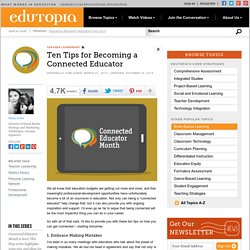
The 4 stages of "getting" Twitter. 10 Predictions for Personalized Learning for 2013. The main change that will happen in teaching and learning in 2013 will be about empowerment.
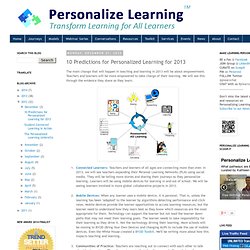
Teachers and learners will be more empowered to take charge of their learning. We will see this through the evidence they share as they learn. Connected Learners: Teachers and learners of all ages are connecting more than ever.